The Parasitic Dinoflagellates Blastodinium spp. Inhabiting the Gut of Marine, Planktonic Copepods: Morphology, Ecology, and Unrecognized Species Diversity
- PMID: 22973263
- PMCID: PMC3428600
- DOI: 10.3389/fmicb.2012.00305
The Parasitic Dinoflagellates Blastodinium spp. Inhabiting the Gut of Marine, Planktonic Copepods: Morphology, Ecology, and Unrecognized Species Diversity
Abstract
Blastodinium is a genus of dinoflagellates that live as parasites in the gut of marine, planktonic copepods in the World's oceans and coastal waters. The taxonomy, phylogeny, and physiology of the genus have only been explored to a limited degree and, based on recent investigations, we hypothesize that the morphological and genetic diversity within this genus may be considerably larger than presently recognized. To address these issues, we obtained 18S rDNA and ITS gene sequences for Blastodinium specimens of different geographical origins, including representatives of the type species. This genetic information was in some cases complemented with new morphological, ultrastructural, physiological, and ecological data. Because most current knowledge about Blastodinium and its effects on copepod hosts stem from publications more than half a century old, we here summarize and discuss the existing knowledge in relation to the new data generated. Most Blastodinium species possess functional chloroplasts, but the parasitic stage, the trophocyte, has etioplasts and probably a limited photosynthetic activity. Sporocytes and swarmer cells have well-developed plastids and plausibly acquire part of their organic carbon needs through photosynthesis. A few species are nearly colorless with no functional chloroplasts. The photosynthetic species are almost exclusively found in warm, oligotrophic waters, indicating a life strategy that may benefit from copepods as microhabitats for acquiring nutrients in a nutrient-limited environment. As reported in the literature, monophyly of the genus is moderately supported, but the three main groups proposed by Chatton in 1920 are consistent with molecular data. However, we demonstrate an important genetic diversity within the genus and provide evidences for new groups and the presence of cryptic species. Finally, we discuss the current knowledge on the occurrence of Blastodinium spp. and their potential impact on natural copepod populations.
Keywords: Blastodinium; copepod; parasite; phylogeny; plankton; symbiont; ultrastructure.
Figures

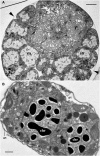
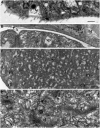



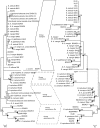



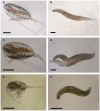
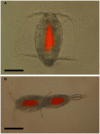
Similar articles
-
Tumour-like anomaly of copepods-an evaluation of the possible causes in Indian marine waters.Environ Monit Assess. 2016 Apr;188(4):244. doi: 10.1007/s10661-016-5230-6. Epub 2016 Mar 24. Environ Monit Assess. 2016. PMID: 27010709
-
Phylogeny, Evidence for a Cryptic Plastid, and Distribution of Chytriodinium Parasites (Dinophyceae) Infecting Copepods.J Eukaryot Microbiol. 2019 Jul;66(4):574-581. doi: 10.1111/jeu.12701. Epub 2018 Dec 11. J Eukaryot Microbiol. 2019. PMID: 30444565
-
Identity and systematic position of Paradinium poucheti and other Paradinium-like parasites of marine copepods based on morphology and nuclear-encoded SSU rDNA.Protist. 2008 Jul;159(3):401-13. doi: 10.1016/j.protis.2008.02.003. Epub 2008 May 15. Protist. 2008. PMID: 18485817
-
Ecology and biogeography of marine parasites.Adv Mar Biol. 2002;43:1-86. doi: 10.1016/s0065-2881(02)43002-7. Adv Mar Biol. 2002. PMID: 12154612 Review.
-
Parasites and phytoplankton, with special emphasis on dinoflagellate infections.J Eukaryot Microbiol. 2004 Mar-Apr;51(2):145-55. doi: 10.1111/j.1550-7408.2004.tb00539.x. J Eukaryot Microbiol. 2004. PMID: 15134249 Review.
Cited by
-
The molecular phylogeny of the type-species of Oodinium Chatton, 1912 (Dinoflagellata: Oodiniaceae), a highly divergent parasitic dinoflagellate with non-dinokaryotic characters.Syst Parasitol. 2015 Feb;90(2):125-35. doi: 10.1007/s11230-014-9538-8. Epub 2015 Feb 6. Syst Parasitol. 2015. PMID: 25655112
-
Shallow Hydrothermal Fluids Shape Microbial Dynamics at the Tagoro Submarine Volcano (Canary Islands, Spain).Environ Microbiol. 2025 Feb;27(2):e70052. doi: 10.1111/1462-2920.70052. Environ Microbiol. 2025. PMID: 39924467 Free PMC article.
-
kLDM: Inferring Multiple Metagenomic Association Networks Based on the Variation of Environmental Factors.Genomics Proteomics Bioinformatics. 2021 Oct;19(5):834-847. doi: 10.1016/j.gpb.2020.06.015. Epub 2021 Feb 17. Genomics Proteomics Bioinformatics. 2021. PMID: 33607296 Free PMC article.
-
Host niche partitioning and coexistence in Amoebophrya and Parvilucifera parasitoids infecting dinoflagellates.ISME Commun. 2025 Jul 29;5(1):ycaf126. doi: 10.1093/ismeco/ycaf126. eCollection 2025 Jan. ISME Commun. 2025. PMID: 40800614 Free PMC article.
-
Endosymbiotic Evolution of Algae, Secondary Heterotrophy and Parasitism.Biomolecules. 2019 Jul 8;9(7):266. doi: 10.3390/biom9070266. Biomolecules. 2019. PMID: 31288476 Free PMC article. Review.
References
-
- Alves-de-Souza C., Cornet C., Nowaczyk A., Gasparini S., Skovgaard A., Guillou L. (2011). Blastodinium spp. infect copepods in the ultra-oligotrophic marine waters of the Mediterranean Sea. Biogeosciences 8, 2125–2136
-
- Apstein B. (1911). Parasiten von Calanus finmarchicus. Wiss. Meeresunters. Abt. Kiel 19, 206–223
-
- Chatton É. (1906). Les Blastodinides, ordre nouveuax de Dinoflagellés parasites. C. R. Acad. Sci. 144, 981–983
LinkOut - more resources
Full Text Sources
Molecular Biology Databases
Research Materials
Miscellaneous

